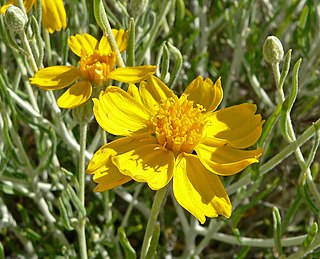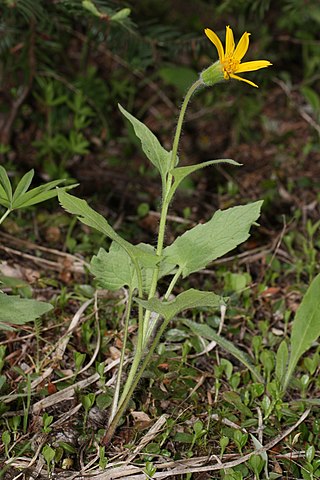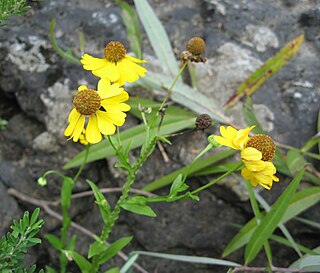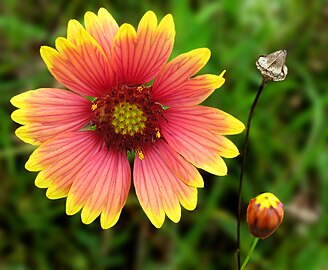
Gaillardia is a genus of flowering plants in the family Asteraceae, native to North and South America. It was named after Maître Gaillard de Charentonneau, an 18th-century French magistrate who was an enthusiastic botanist. The common name may refer to the resemblance of the inflorescence to the brightly patterned blankets made by Native Americans, or to the ability of wild taxa to blanket the ground with colonies. Many cultivars have been bred for ornamental use.

Rudbeckia hirta, commonly called black-eyed Susan, is a North American flowering plant in the family Asteraceae, native to Eastern and Central North America and naturalized in the Western part of the continent as well as in China. It has now been found in all 10 Canadian Provinces and all 48 of the states in the contiguous United States.

Monoptilon bellioides, the desert star, also called Mojave desertstar, is a desert flowering plant in the family Asteraceae.

Anisocoma acaulis, commonly known as the scale bud, is a wildflower found in the Mojave, Colorado Deserts, and California's Owens Valley above 610 metres (2,000 ft), up to about 2,100 m (7,000 ft).

Geraea canescens, commonly known as desert sunflower, hairy desert sunflower, or desert gold, is an annual plant in the family Asteraceae. The genus name comes from the Greek geraios, referring to the white hairs on the fruits.

Psilostrophe cooperi is a flowering plant in the daisy family known by the common names Cooper's paper daisy and whitestem paperflower. It is native to the Mojave and Sonoran Deserts of California, the Southwestern United States, and northwestern Mexico.

Erigeron philadelphicus, the Philadelphia fleabane, is a species of flowering plant in the composite family (Asteraceae). Other common names include common fleabane, daisy fleabane, frost-root, marsh fleabane, poor robin's plantain, skevish or skervish, and, in the British Isles, robin's-plantain, but all of these names are shared with other species of fleabanes (Erigeron). It is native to North America and has been introduced to Eurasia.

Erigeron glaucus is a species of flowering plant in the family Asteraceae known by the common name seaside fleabane, beach aster, or seaside daisy. It is native to the West Coast of the United States.

Gaillardia aristata is a North American species of flowering plant in the sunflower family, known by the common names common blanketflower and common gaillardia. This perennial wildflower is widespread across much of North America, from Yukon east to Québec and south as far as California, Arizona, Illinois, and Connecticut, although it may be naturalized rather than native in parts of that range. It is also naturalized in scattered locations in Europe, Australia, and South America.

Hulsea algida is a species of flowering plant in the daisy family, known by the common name Pacific hulsea or alpine gold. It is native to the western United States.

Agoseris aurantiaca is a species of plant in the family Asteraceae, commonly called orange agoseris or mountain dandelion. It is widespread in western North America.

Arnica cordifolia is a species of arnica in the sunflower family, known by the common name heartleaf arnica. It is native to western North America.

Arnica fulgens is a species of arnica known by the common names foothill arnica and hillside arnica. It is native to western North America, from British Columbia east to Saskatchewan and south as far as Inyo County, California, and McKinley County, New Mexico. It grows in open, grassy areas.

Crepis acuminata is a North American species of flowering plant in the family Asteraceae known by the common name tapertip hawksbeard. It is native to the western United States where it grows in many types of open habitat.

Machaeranthera tanacetifolia is a species of flowering plant in the family Asteraceae known by the common names tansyleaf tansyaster and Tahoka daisy.

Helenium flexuosum is a North American plant species in the daisy family known by the common name purple sneezeweed. It is widespread across much of eastern and central United States and Canada, from Nova Scotia west to Ontario, Minnesota, and Kansas, south to Florida, Louisiana, and eastern Texas.

Gaillardia pinnatifida, the Hopi blanketflower or red dome blanketflower, is a perennial plant in the family Asteraceae found in northern Mexico and in the south-central and southwestern United States.

Arnica lanceolata is a North American species of flowering plant in the family Asteraceae, known by the common name clasping arnica or lanceleaf arnica. It has a disjunct (discontinuous) distribution in western North America and northeastern North America.

Cirsium texanum is a species of plant in the tribe Cardueae within the family Asteraceae found in North America. Common names include Texas thistle, Texas purple thistle or southern thistle. The species is native to northern Mexico and the southern Great Plains of the south-central United States. It grows in prairies and roadsides.

Erigeron poliospermus is a species of flowering plant in the family Asteraceae known by the common names gray-seeded fleabane, purple cushion fleabane, and hairy-seed fleabane. Native to western North America, it is mainly found to the east of the Cascade Range in Washington, Oregon, and Idaho.



























